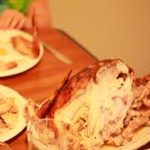Planning to cook Thanksgiving dinner?
The Lawhead Team would like to share some Thanksgiving safety tips to make sure all kitchen activities and turkey dinner consumption is done safely!
Thanksgiving Kitchen Safety Tips:
- Stay in the kitchen when you are cooking on the stove-top so you can keep an eye on the food and stay in your home when cooking your turkey, checking on it frequently.
- Keep children away from the stove. The stove will be hot and kids should stay 3 feet away.
- Keep the floor clear when preparing Thanksgiving dinner so you don’t trip over kids, toys, pocketbooks or bags.
- Make sure your smoke alarms are working. Test them by pushing the test button.
Thawing The Turkey – Thawing Thanksgiving turkeys must be kept at a safe temperature. The “danger zone” is between 40 and 140°F — the temperature range where food-borne bacteria multiply rapidly. While frozen, a turkey is safe indefinitely, but as soon as it begins to thaw, bacteria that may have been present before freezing can begin to grow again, if it is in the “danger zone.”
Preparing The Turkey – Bacteria present on raw poultry can contaminate your hands, utensils, and work surfaces as you prepare the turkey. If these areas are not cleaned thoroughly before working with other foods, bacteria from the raw poultry can then be transferred to other foods. After working with raw poultry, always wash your hands, utensils, and work surfaces before they touch other foods.
 Stuffing The Turkey – For optimal safety and uniform done-ness, cook your Thanksgiving stuffing outside the turkey in a casserole dish. However, if you place stuffing inside the turkey, do so just before cooking, and use a food thermometer. Make sure the center of the stuffing reaches a safe minimum internal temperature of 165°F. Bacteria can survive in stuffing that has not reached 165°F, possibly resulting in food-borne illness.
Stuffing The Turkey – For optimal safety and uniform done-ness, cook your Thanksgiving stuffing outside the turkey in a casserole dish. However, if you place stuffing inside the turkey, do so just before cooking, and use a food thermometer. Make sure the center of the stuffing reaches a safe minimum internal temperature of 165°F. Bacteria can survive in stuffing that has not reached 165°F, possibly resulting in food-borne illness.
Cooking The Turkey – Set the oven temperature no lower than 325°F and be sure the turkey is completely thawed. Place turkey breast-side up on a flat wire rack in a shallow roasting pan 2 to 2-1/2 inches deep. Check the internal temperature at the center of the stuffing and meaty portion of the breast, thigh, and wing joint using a food thermometer. Cooking times will vary. The food thermometer must reach a safe minimum internal temperature of 165°F. Let your Thanksgiving turkey stand 20 minutes before removing all stuffing from the cavity and carving the meat.

